平行于棱锥底面的截面的性质pingxingyu lengzhui dimian de jiemian de xingzhi
定理1 若棱锥被平行于底面的平面所截,则:❶棱锥的侧棱和高被这平面分成比例线段;
❷所得的截面是和底面相似的多边形;
❸截面面积与底面面积之比,等于从顶点到截面和从顶点到底面的距离平方的比.
如图1,在棱锥S-ABCDE中,SH是高,截面
| A1B1C1D1E1平行于底面,并与高SH交于H1,则: |


❷多边形A1B1C1D1E1∽多边形 |


图1
上面的性质是研究棱锥的体积、棱台的截面和体积的基础.
定理2 若两个等高的棱锥,分别被平行于底面的平面所截,并且顶点到截面的距离相等,则两个截面面积的比等于两个底面面积的比.

图2
如图2,两个棱锥S和S1被平行于底面的平面所截,所得截面分别是多边形A1B1C1D1和M1N1P1,两个棱锥的高都是h,从顶点到截面的距离都是h1,则
